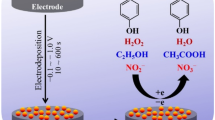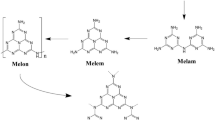Abstract
In this study, gold nanoparticles were supported at graphene derivatives (AuNPs@GDs) from chloroauric acid and graphene oxide (GO) by using sodium citrate, L-ascorbic acid, and 4-(2-hydroxyethyl)-1-piperazineethane-sulfonic acid (HEPES) as green reductants to evaluate the catalytic activity in the 4-nitrophenol (4-NP) reduction system. Among the three reductants, HEPES which derived AuNP@GD (3) exhibited up to 8.44-fold higher catalytic activity compared with sodium citrate and L-ascorbic acid. To evaluate the influence of mass ratio between Au and GO on the catalytic activity, we controlled adding amounts of chloroauric acid while the other conditions using HEPES were fixed. Notably, decreasing the mass ratio of Au/GO from 0.59 to 0.10 increased the rate constant in the range of 7.6 × 10−3 to 16.1 × 10−3/s. However, when the turnover frequency (TOF) was considered, the maximum value was obtained when Au/GO was 0.39. It can be concluded that AuNPs@GD (4) synthesized using HEPES significantly improved the catalytic activity in both rate constant (10.4 × 10−3/s) and TOF (8.08 × 10−5 mol/g·s) in 4-NP reduction. These results suggest that the type of reductants used to synthesize AuNPs@GDs is a significant factor on the catalytic activity and that GO can help increase the catalytic activity, but has an effective ratio with Au.









Similar content being viewed by others
References
Hvolbæk B, Janssens TV, Clausen BS, Falsig H, Christensen CH, Nørskov JK (2007) Catalytic activity of Au nanoparticles. Nano Today 2:14–18. https://doi.org/10.1016/S1748-0132(07)70113-5
Mikami Y, Dhakshinamoorthy A, Alvaro M, García H (2013) Catalytic activity of unsupported gold nanoparticles. Catal Sci Technol 3(1):58–69. https://doi.org/10.1039/C2CY20068F
Corma A, Garcia H (2008) Supported gold nanoparticles as catalysts for organic reactions. Chem Soc Rev 37(9):2096–2126. https://doi.org/10.1039/B707314N
Hashmi ASK, Hutchings GJ (2006) Gold catalysis. Angew Chem Int Ed 45:7896–7936. https://doi.org/10.1002/anie.200602454
Hashmi ASK (2007) Gold-catalyzed organic reactions. Chem Rev 107:3180–3211. https://doi.org/10.1021/cr000436x
Chairam S, Konkamdee W, Parakhun R (2015) Starch-supported gold nanoparticles and their use in 4-nitrophenol reduction. J Saudi Chem Soc 21:656–663. https://doi.org/10.1016/j.jscs.2015.11.001
Seral-Ascaso A, Luquin A, Lázaro MJ, Germán F, Laguna M, Muñoz E (2013) Synthesis and application of gold-carbon hybrids as catalysts for the hydroamination of alkynes. Appl Catal A-Gen 456:88–95. https://doi.org/10.1016/j.apcata.2013.02.008
Spilarewicz-Stanek K, Kisielewska A, Ginter J, Bałuszyńska K, Piwoński I (2016) Elucidation of the function of oxygen moieties on graphene oxide and reduced graphene oxide in the nucleation and growth of silver nanoparticles. RSC Adv 6:60056–60067. https://doi.org/10.1039/C6RA10483E
Morimoto N, Yamamoto SI, Takeuchi Y, Nishina Y (2013) Palladium on graphene: the in situ generation of a catalyst for the chemoselective reduction of α, β-unsaturated carbonyl compounds. RSC Adv 3:15608–15612. https://doi.org/10.1039/C3RA42150C
Li J, Liu CY, Liu Y (2012) Au/graphene hydrogel: synthesis, characterization and its use for catalytic reduction of 4-nitrophenol. J Mater Chem 22:8426–8430. https://doi.org/10.1039/C2JM16386A
Lu W, Ning R, Qin X, Zhang Y, Chang G, Liu S, Luo Y, Sun X (2011) Synthesis of Au nanoparticles decorated graphene oxide nanosheets: noncovalent functionalization by TWEEN 20 in situ reduction of aqueous chloroaurate ions for hydrazine detection and catalytic reduction of 4-nitrophenol. J Hazard Mater 197:320–326. https://doi.org/10.1016/j.jhazmat.2011.09.092
Dauthal P, Mukhopadhyay M (2012) Prunus domestica fruit extract-mediated synthesis of gold nanoparticles and its catalytic activity for 4-nitrophenol reduction. Ind Eng Chem Res 51:13014–13020. https://doi.org/10.1021/ie300369g
Chang G, Luo Y, Lu W, Qin X, Asiri AM, Al-Youbi AO, Sun X (2012) Ag nanoparticles decorated polyaniline nanofibers: synthesis, characterization, and applications toward catalytic reduction of 4-nitrophenol and electrochemical detection of H2O2 and glucose. Catal Sci Technol 2:800–806. https://doi.org/10.1039/c2cy00454b
Dash SS, Bag BG (2014a) Synthesis of gold nanoparticles using renewable Punica granatum juice and study of its catalytic activity. Appl Nanosci 4:55–59. https://doi.org/10.1007/s13204-012-0179-4
Dash SS, Majumdar R, Sikder AK, Bag BG, Patra BK (2014b) Saraca indica bark extract mediated green synthesis of polyshaped gold nanoparticles and its application in catalytic reduction. Appl Nanosci 4:485–490. https://doi.org/10.1007/s13204-013-0223-z
Choi Y, Choi M-J, Cha S-H, Kim YS, Cho S, Park Y (2014) Catechin-capped gold nanoparticles: green synthesis, characterization, and catalytic activity toward 4-nitrophenol reduction. Nanoscale Res Lett 9:103 (8pp). https://doi.org/10.1186/1556-276X-9-103
Joseph S, Mathew B (2015) Microwave assisted facile green synthesis of silver and gold nanocatalysts using the leaf extract of Aerva lanata. Spectrochim Acta Mol Biomol Spectrosc 136:1371–1379. https://doi.org/10.1016/j.saa.2014.10.023
Lee YJ, Cha SH, Lee KJ, Kim YS, Park Y (2015) Plant extract (Bupleurum falcatum) as a green factory for biofabrication of gold nanoparticles. Nat Prod Commun 10:1593–1596
Seo YS, Ahn EY, Park J, Kim TY, Hong JE, Kim K, Park Y, Park Y (2017) Catalytic reduction of 4-nitrophenol with gold nanoparticles synthesized by caffeic acid. Nanoscale Res Lett 12:7. https://doi.org/10.1186/s11671-016-1776-z
Zhao B, Mele G, Pio I, Li J, Palmisano L, Vasapollo G (2010) Degradation of 4-nitrophenol (4-NP) using Fe–TiO2 as a heterogeneous photo-Fenton catalyst. J Hazard Mater 176:569–574. https://doi.org/10.1016/j.jhazmat.2009.11.066
Chiou JR, Lai BH, Hsu KC, Chen DH (2013) One-pot green synthesis of silver/iron oxide composite nanoparticles for 4-nitrophenol reduction. J Hazard Mater 248:394–400. https://doi.org/10.1016/j.jhazmat.2013.01.030
Kong BS, Geng J, Jung HT (2009) Layer-by-layer assembly of graphene and gold nanoparticles by vacuum filtration and spontaneous reduction of gold ions. Chem Commun 16:2174–2176. https://doi.org/10.1039/B821920F
Zhang Y, Liu S, Lu W, Wang L, Tian J, Sun X (2011) In situ green synthesis of Au nanostructures on graphene oxide and their application for catalytic reduction of 4-nitrophenol. Catal Sci Technol 1:1142–1144. https://doi.org/10.1039/C1CY00205H
Fu WL, Zhen SJ, Huang CZ (2013) One-pot green synthesis of graphene oxide/gold nanocomposites as SERS substrates for malachite green detection. Analyst 138:3075–3081. https://doi.org/10.1039/C3AN00018D
Nergiz SZ, Gandra N, Singamaneni S (2014) Self-assembled high aspect ratio gold nanostar/graphene oxide hybrid nanorolls. Carbon 66:585–591. https://doi.org/10.1016/j.carbon.2013.09.042
Song J, Xu L, Xing R, Li Q, Zhou C, Liu D, Song H (2014) Synthesis of Au/graphene oxide composites for selective and sensitive electrochemical detection of ascorbic acid. Sci Rep 4:7515. https://doi.org/10.1038/srep07515
Movahed SK, Fakharian M, Dabiri M, Bazgir A (2014) Gold nanoparticle decorated reduced graphene oxide sheets with high catalytic activity for Ullmann homocoupling. RSC Adv 4:5243–5247. https://doi.org/10.1039/C3RA45518A
Żelechowska K, Kondratowicz I, Gazda M (2016) Graphene hydrogels with embedded metal nanoparticles as efficient catalysts in 4-nitrophenol reduction and methylene blue decolorization. Pol J Chem Technol 18:47–55. https://doi.org/10.1515/pjct-2016-0070
Qin X, Li Q, Asiri AM, Al-Youbi AO, Sun X (2014) One-pot synthesis of Au nanoparticles/reduced graphene oxide nanocomposites and their application for electrochemical H2O2, glucose, and hydrazine sensing. Gold Bull 47:3–8. https://doi.org/10.1007/s13404-013-0094-9
Zhang Y, Liu S, Wang L, Qin X, Tian J, Lu W, Guohui C, Sun X (2012) One-pot green synthesis of Ag nanoparticles-graphene nanocomposites and their applications in SERS, H2O2, and glucose sensing. RSC Adv 2:538–545. https://doi.org/10.1039/C1RA00641J
Penniston KL, Nakada SY, Holmes RP, Assimos DG (2008) Quantitative assessment of citric acid in lemon juice, lime juice, and commercially-available fruit juice products. J Endourol 22:567–570. https://doi.org/10.1089/end.2007.0304
Xie J, Lee JY, Wang DI (2007) Seedless, surfactantless, high-yield synthesis of branched gold nanocrystals in HEPES buffer solution. Chem Mater 19:2823–2830. https://doi.org/10.1021/cm0700100
Wang Q, Wang Q, Li M, Szunerits S, Boukherroub R (2016) One-step synthesis of Au nanoparticle–graphene composites using tyrosine: electrocatalytic and catalytic properties. New J Chem 40:5473–5482. https://doi.org/10.1039/C5NJ03532E
Seo YS, Cha SH, Yoon HR, Kang YH, Park Y (2015) Caffeic acid: potential applications in nanotechnology as a green reducing agent for sustainable synthesis of gold nanoparticles. Nat Prod Commun 10:627–630
Wunder S, Polzer F, Lu Y, Mei Y, Ballauff M (2010) Kinetic analysis of catalytic reduction of 4-nitrophenol by metallic nanoparticles immobilized in spherical polyelectrolyte brushes. J Phys Chem C 114:8814–8820. https://doi.org/10.1021/jp101125j
Ciganda R, Li N, Deraedt C, Gatard S, Zhao P, Salmon L, Herández R, Ruiz J, Astruc D (2014) Gold nanoparticles as electron reservoir redox catalysts for 4-nitrophenol reduction: a strong stereoelectronic ligand influence. Chem Commun 50:10126–10129. https://doi.org/10.1039/C4CC04454A
Panigrahi S, Basu S, Praharaj S, Pande S, Jana S, Pal A, Ghosh SK, Pal T (2007) Synthesis and size-selective catalysis by supported gold nanoparticles: study on heterogeneous and homogeneous catalytic process. J Phys Chem C 111:4596–4605. https://doi.org/10.1021/jp067554u
Saha S, Pal A, Kundu S, Basu S, Pal T (2009) Photochemical green synthesis of calcium-alginate-stabilized Ag and Au nanoparticles and their catalytic application to 4-nitrophenol reduction. Langmuir 26:2885–2893. https://doi.org/10.1021/la902950x
Lin C, Tao K, Hua D, Ma Z, Zhou S (2013) Size effect of gold nanoparticles in catalytic reduction of p-nitrophenol with NaBH4. Molecules 18:12609–12602. https://doi.org/10.3390/molecules181012609
Funding
This research was supported by Basic Science Research Program through the National Research Foundation of Korea (NRF) funded by the Ministry of Education, Republic of Korea (NRF-2016R1D1A1B04930774 and NRF-2017R1D1A3B03035738) and was also supported by Korea Health Technology R&D Project through the Korea Health Industry Development Institute (KHIDI) funded by the Ministry of Health & Welfare, Republic of Korea (HI18C1728).
Author information
Authors and Affiliations
Corresponding author
Ethics declarations
Competing interests
The authors declare that they have no competing interests.
Additional information
Publisher’s note
Springer Nature remains neutral with regard to jurisdictional claims in published maps and institutional affiliations.
Rights and permissions
About this article
Cite this article
Choi, D.H., Hong, J.E., Jung, Y. et al. Synthesis of gold nanoparticles supported at graphene derivatives using green reductants and evaluation of their catalytic activity in 4-nitrophenol reduction. Gold Bull 52, 165–174 (2019). https://doi.org/10.1007/s13404-019-00258-w
Received:
Accepted:
Published:
Issue Date:
DOI: https://doi.org/10.1007/s13404-019-00258-w




